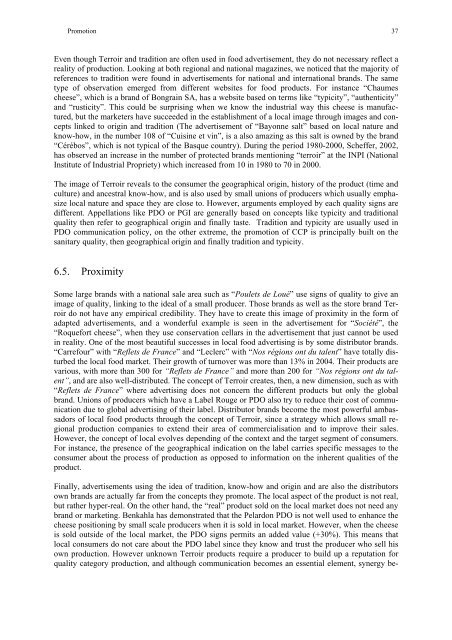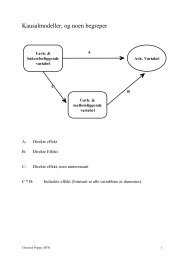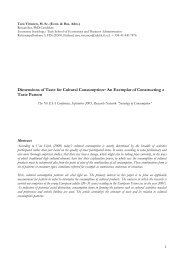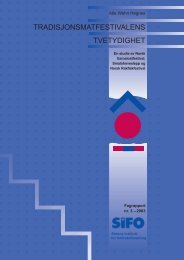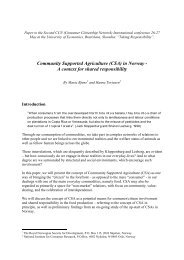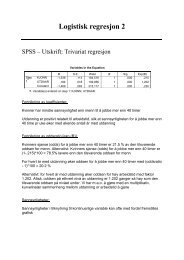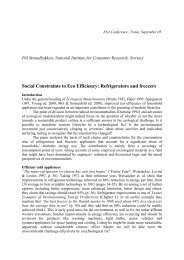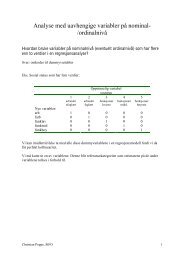Rapport nr - SIFO
Rapport nr - SIFO
Rapport nr - SIFO
- No tags were found...
You also want an ePaper? Increase the reach of your titles
YUMPU automatically turns print PDFs into web optimized ePapers that Google loves.
Promotion 37Even though Terroir and tradition are often used in food advertisement, they do not necessary reflect areality of production. Looking at both regional and national magazines, we noticed that the majority ofreferences to tradition were found in advertisements for national and international brands. The sametype of observation emerged from different websites for food products. For instance “Chaumescheese”, which is a brand of Bongrain SA, has a website based on terms like “typicity”, “authenticity”and “rusticity”. This could be surprising when we know the industrial way this cheese is manufactured,but the marketers have succeeded in the establishment of a local image through images and conceptslinked to origin and tradition (The advertisement of “Bayonne salt” based on local nature andknow-how, in the number 108 of “Cuisine et vin”, is a also amazing as this salt is owned by the brand“Cérébos”, which is not typical of the Basque country). During the period 1980-2000, Scheffer, 2002,has observed an increase in the number of protected brands mentioning “terroir” at the INPI (NationalInstitute of Industrial Propriety) which increased from 10 in 1980 to 70 in 2000.The image of Terroir reveals to the consumer the geographical origin, history of the product (time andculture) and ancestral know-how, and is also used by small unions of producers which usually emphasizelocal nature and space they are close to. However, arguments employed by each quality signs aredifferent. Appellations like PDO or PGI are generally based on concepts like typicity and traditionalquality then refer to geographical origin and finally taste. Tradition and typicity are usually used inPDO communication policy, on the other extreme, the promotion of CCP is principally built on thesanitary quality, then geographical origin and finally tradition and typicity.6.5. ProximitySome large brands with a national sale area such as “Poulets de Loué” use signs of quality to give animage of quality, linking to the ideal of a small producer. Those brands as well as the store brand Terroirdo not have any empirical credibility. They have to create this image of proximity in the form ofadapted advertisements, and a wonderful example is seen in the advertisement for “Société”, the“Roquefort cheese”, when they use conservation cellars in the advertisement that just cannot be usedin reality. One of the most beautiful successes in local food advertising is by some distributor brands.“Carrefour” with “Reflets de France” and “Leclerc” with “Nos régions ont du talent” have totally disturbedthe local food market. Their growth of turnover was more than 13% in 2004. Their products arevarious, with more than 300 for “Reflets de France” and more than 200 for “Nos régions ont du talent”,and are also well-distributed. The concept of Terroir creates, then, a new dimension, such as with“Reflets de France” where advertising does not concern the different products but only the globalbrand. Unions of producers which have a Label Rouge or PDO also try to reduce their cost of communicationdue to global advertising of their label. Distributor brands become the most powerful ambassadorsof local food products through the concept of Terroir, since a strategy which allows small regionalproduction companies to extend their area of commercialisation and to improve their sales.However, the concept of local evolves depending of the context and the target segment of consumers.For instance, the presence of the geographical indication on the label carries specific messages to theconsumer about the process of production as opposed to information on the inherent qualities of theproduct.Finally, advertisements using the idea of tradition, know-how and origin and are also the distributorsown brands are actually far from the concepts they promote. The local aspect of the product is not real,but rather hyper-real. On the other hand, the “real” product sold on the local market does not need anybrand or marketing. Benkahla has demonstrated that the Pelardon PDO is not well used to enhance thecheese positioning by small scale producers when it is sold in local market. However, when the cheeseis sold outside of the local market, the PDO signs permits an added value (+30%). This means thatlocal consumers do not care about the PDO label since they know and trust the producer who sell hisown production. However unknown Terroir products require a producer to build up a reputation forquality category production, and although communication becomes an essential element, synergy be-


